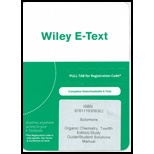
Interpretation:
The relative
Concept Introduction:
Electrophiles are electron deficient species which has positive or partially positive charge. Lewis acids are electrophiles which accept electron pair.
Nucleophiles are electron rich species which has negative or partially negative charge. Lewis bases are nucleophiles which donate electron pair.
Free radical is an atom, molecule or ion that has unpaired electrons which makes it highly chemically reactive.
Substitution reaction: A reaction in which one of the hydrogen atoms of a hydrocarbon or a
Elimination reaction: A reaction in which two substituent groups are detached and a double bond is formed is called elimination reaction.
Addition reaction: It is the reaction in which unsaturated bonds are converted to saturated molecules by the addition of molecules.
Carbocation is a molecule having a carbon atom bearing three bonds and a positive formal charge.
Carbocation are generally unstable because they do not have eight electrons to satisfy the octet rule.
The order of stability of carbocation is such that the tertiary carbocation is the most stable whereas the primary carbocation is the least stable, and secondary carbocation lies between primary and tertiary carbocations.
If primary carbocation is obtained in product, it rearranges itself to secondary or tertiary carbocation to form more stable product.
If secondary carbocation is obtained in product, it rearranges itself to tertiary carbocation to form more stable product.
The stability of carbocation:
The addition reaction is the reaction in which unsaturated bonds are converted into saturated molecules by the addition of molecules.
The primary carbon atom is the one in which the required atom of carbon is attached to only one other atom of carbon. It is denoted by
The secondary carbon atom is the one in which the required atom of carbon is attached to two other atoms of carbon. It is denoted by
The tertiary carbon atom is the one in which the required atom of carbon is attached to three other atoms of carbon. It is denoted by
Want to see the full answer?
Check out a sample textbook solution
Chapter 8 Solutions
ORGANIC CHEMISTRY-ETEXT REG ACCESS
- Which of the following is true for a particular reaction if ∆G° is -40.0 kJ/mol at 290 K and –20.0 kJ/mol at 390 K?arrow_forwardWhat is the major product of the following reaction? O O OH OH 1. BH 2. H₂O₂, NaOH OH OHarrow_forwardDraw the products formed when each ester is hydrolyzed with water and sulfuric acid.arrow_forward
- Draw the products of the hydrolysis reaction between the ester molecule and water. Determine the products of the following reaction.arrow_forwardWhat is the unsaturation number for compounds with the formula C₂H₁₂Cl₂? O õ õ o o 4 3arrow_forwardIndicate the product obtained (formula). F3C. CF3 Br NH2 NH OMe K2CO3, DABCO, DMFarrow_forward
 Organic ChemistryChemistryISBN:9781305580350Author:William H. Brown, Brent L. Iverson, Eric Anslyn, Christopher S. FootePublisher:Cengage Learning
Organic ChemistryChemistryISBN:9781305580350Author:William H. Brown, Brent L. Iverson, Eric Anslyn, Christopher S. FootePublisher:Cengage Learning
 Organic Chemistry: A Guided InquiryChemistryISBN:9780618974122Author:Andrei StraumanisPublisher:Cengage Learning
Organic Chemistry: A Guided InquiryChemistryISBN:9780618974122Author:Andrei StraumanisPublisher:Cengage Learning


